Abstract
Cerebral ischaemia of the immature brain may result in cavitating periventricular leucomalacia (PVL), an important association of cerebral palsy. Hypoxanthine measured by high performance liquid chromatography was used as a marker of peripartum hypoxia and ischaemia in 116 infants at risk of PVL. PVL was detected by ultrasound. The 81 infants who were unaffected had median (range) gestation of 30 weeks (24-32), weight of 1336 g (724-3790), and a plasma hypoxanthine concentration of 7.8 mumol/l (2.4-48.9). The seven infants who had cavitating PVL had a median gestation of 28 weeks (26-30), weight of 1165 g (682-1860), and a hypoxanthine concentration of 31.9 mumol/l (7.1-149). Cavitating PVL was significantly dependent only on hypoxanthine when controlling for the effects of weight and gestation. This suggests that peripartum hypoxia-ischaemia may be one of the aetiological factors in cavitating PVL. Oxidation of hypoxanthine during reperfusion generates free radicals which may contribute to the tissue destruction of PVL. The association of hypoxia-ischaemia with PVL suggests that PVL may be modified by reducing free radical activity.
Full text
PDF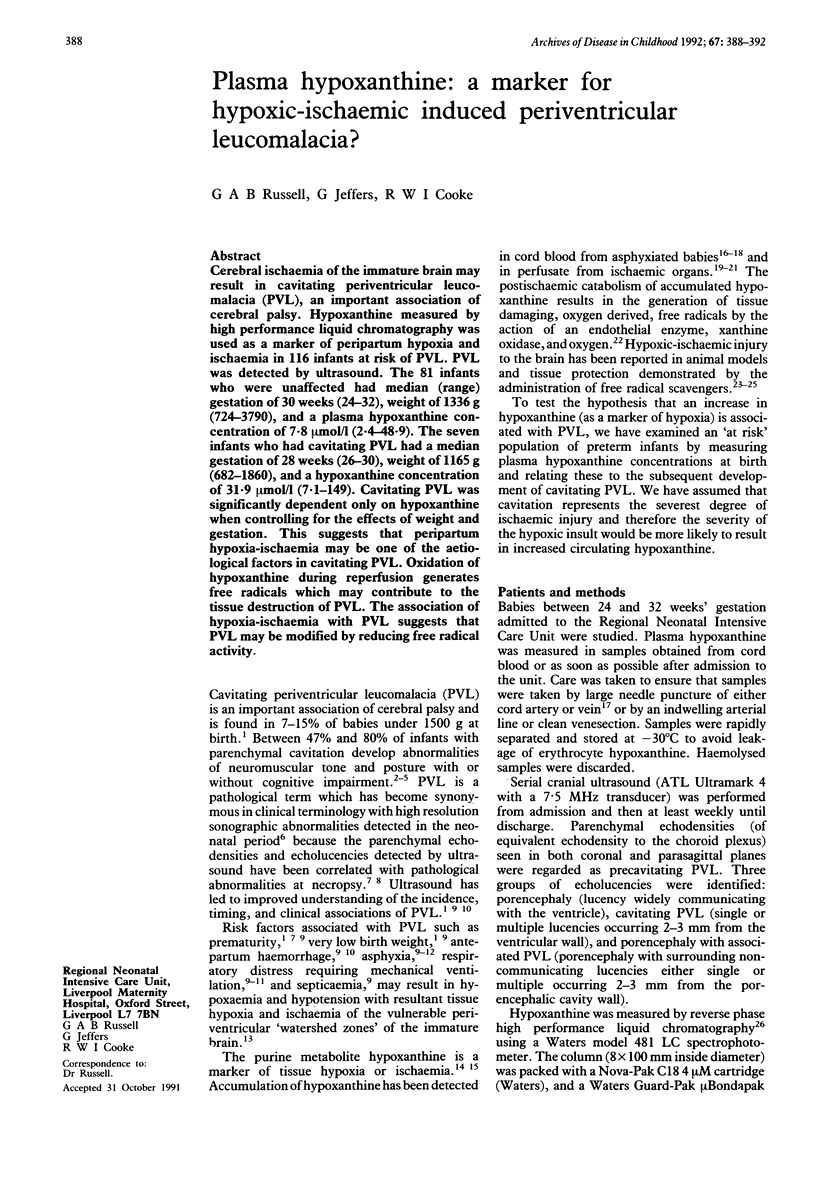
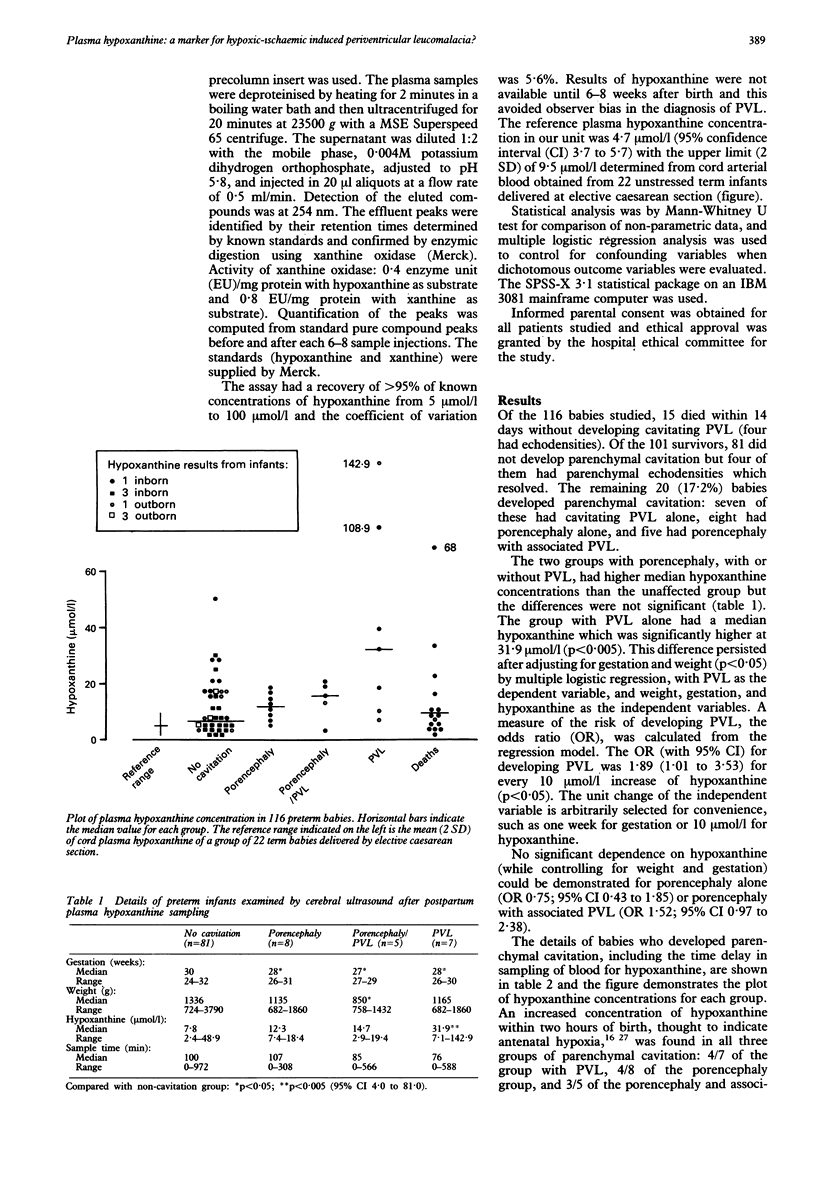
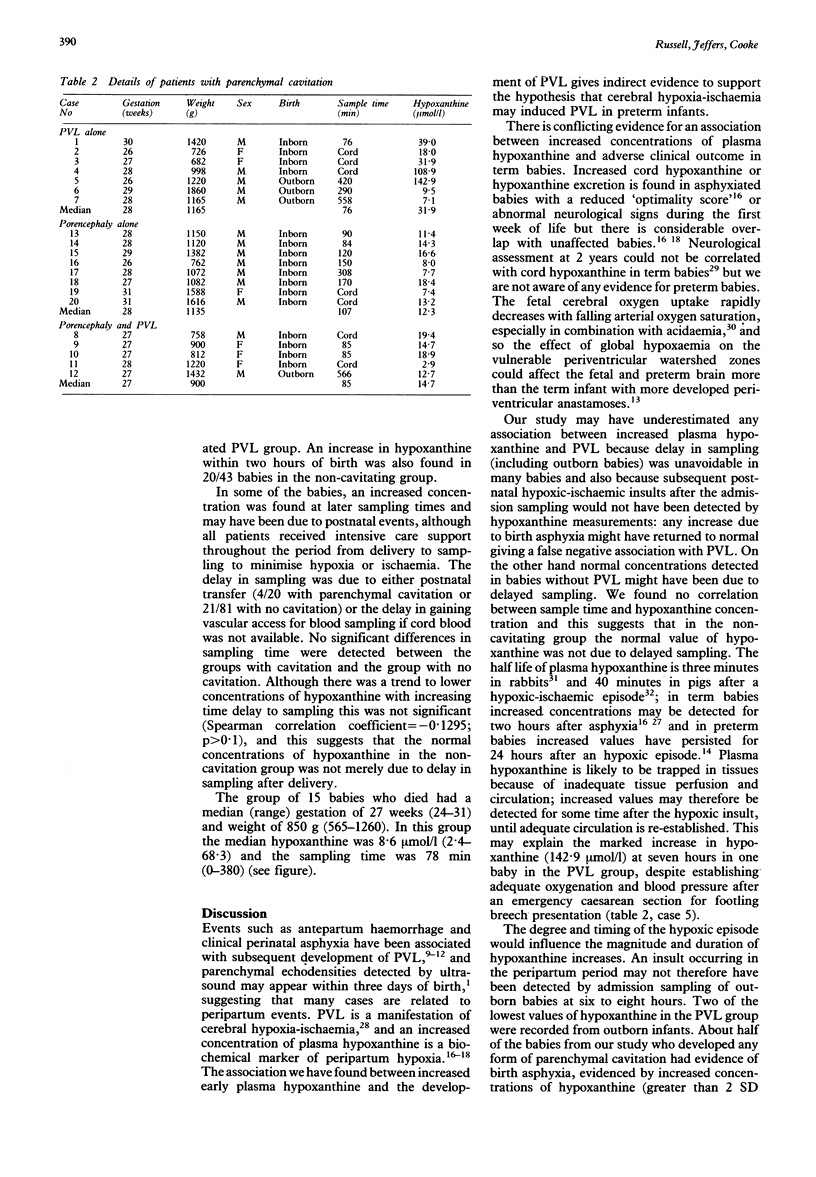
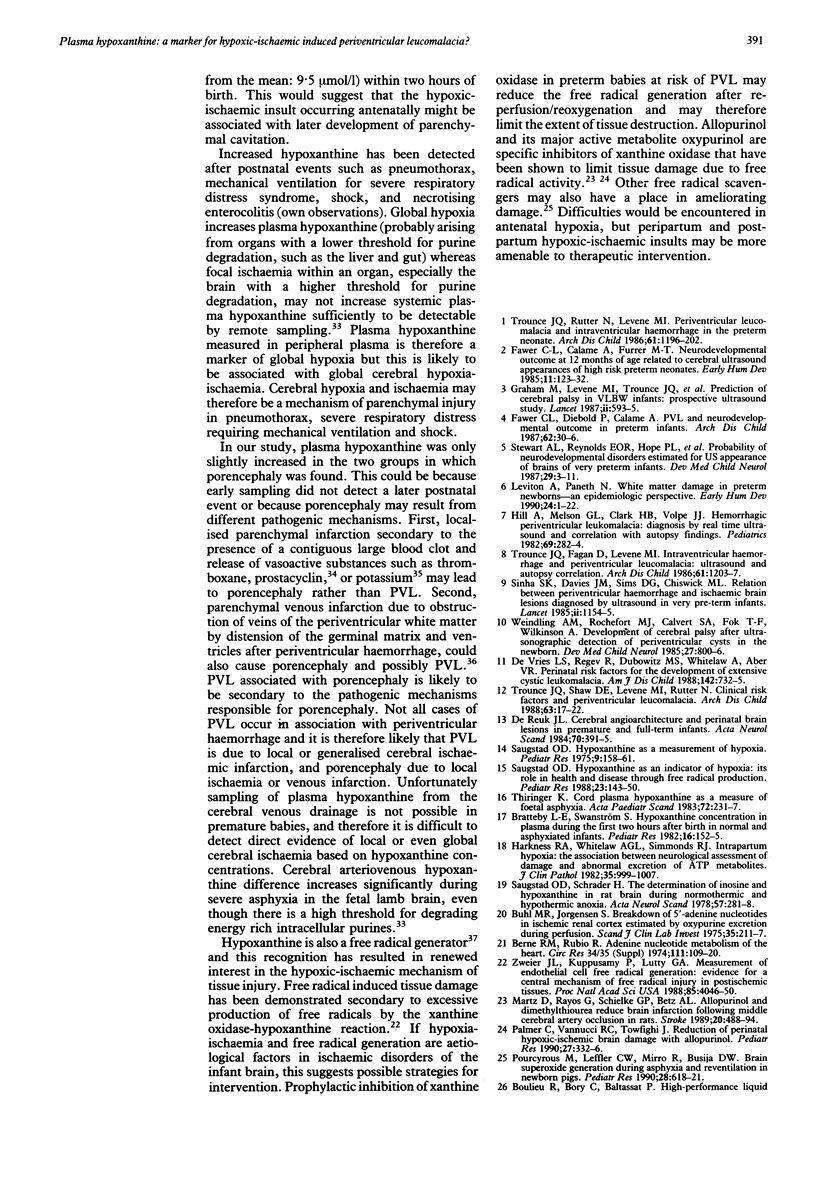
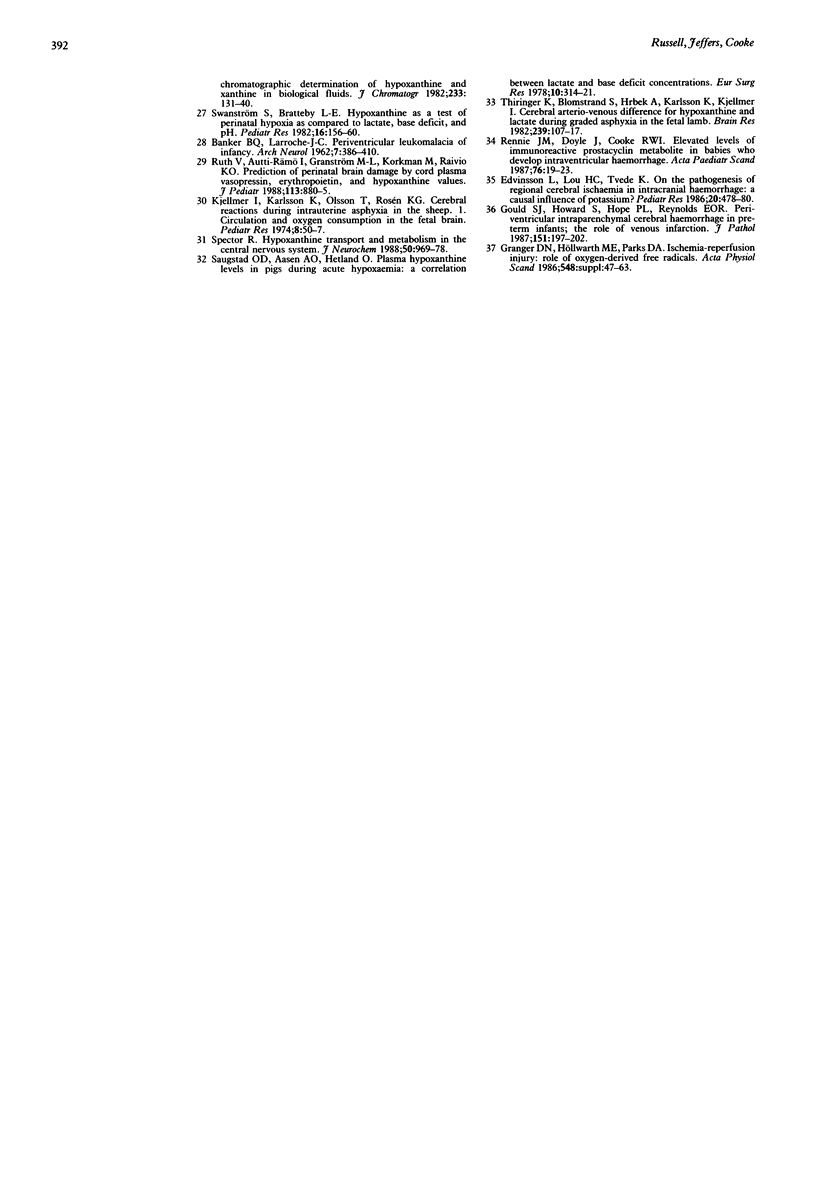
Selected References
These references are in PubMed. This may not be the complete list of references from this article.
- BANKER B. Q., LARROCHE J. C. Periventricular leukomalacia of infancy. A form of neonatal anoxic encephalopathy. Arch Neurol. 1962 Nov;7:386–410. doi: 10.1001/archneur.1962.04210050022004. [DOI] [PubMed] [Google Scholar]
- Berne R. M., Rubio R. Adenine nucleotide metabolism in the heart. Circ Res. 1974 Sep;35 (Suppl 3):109–120. [PubMed] [Google Scholar]
- Boulieu R., Bory C., Baltassat P., Gonnet C. High-performance liquid chromatographic determination of hypoxanthine and xanthine in biological fluids. J Chromatogr. 1982 Dec 10;233:131–140. doi: 10.1016/s0378-4347(00)81739-9. [DOI] [PubMed] [Google Scholar]
- Bratteby L. E., Swanström S. Hypoxanthine concentration in plasma during the first two hours after birth in normal and asphyxiated infants. Pediatr Res. 1982 Feb;16(2):152–155. doi: 10.1203/00006450-198202000-00015. [DOI] [PubMed] [Google Scholar]
- Buhl M. R., Jörgensen S. Breakdown of 5'-adenine nucleotides in ischaemic renal cortex estimated by oxypurine excretion during perfusion. Scand J Clin Lab Invest. 1975 May;35(3):211–217. doi: 10.1080/00365517509095732. [DOI] [PubMed] [Google Scholar]
- Colombo M., Mannucci P. M., Carnelli V., Savidge G. F., Gazengel C., Schimpf K. Transmission of non-A, non-B hepatitis by heat-treated factor VIII concentrate. Lancet. 1985 Jul 6;2(8445):1–4. doi: 10.1016/s0140-6736(85)90055-8. [DOI] [PubMed] [Google Scholar]
- De Reuck J. L. Cerebral angioarchitecture and perinatal brain lesions in premature and full-term infants. Acta Neurol Scand. 1984 Dec;70(6):391–395. doi: 10.1111/j.1600-0404.1984.tb00843.x. [DOI] [PubMed] [Google Scholar]
- Edvinsson L., Lou H. C., Tvede K. On the pathogenesis of regional cerebral ischemia in intracranial hemorrhage: a causal influence of potassium? Pediatr Res. 1986 May;20(5):478–480. doi: 10.1203/00006450-198605000-00019. [DOI] [PubMed] [Google Scholar]
- Fawer C. L., Calame A., Furrer M. T. Neurodevelopmental outcome at 12 months of age related to cerebral ultrasound appearances of high risk preterm infants. Early Hum Dev. 1985 Jul;11(2):123–132. doi: 10.1016/0378-3782(85)90099-4. [DOI] [PubMed] [Google Scholar]
- Fawer C. L., Diebold P., Calame A. Periventricular leucomalacia and neurodevelopmental outcome in preterm infants. Arch Dis Child. 1987 Jan;62(1):30–36. doi: 10.1136/adc.62.1.30. [DOI] [PMC free article] [PubMed] [Google Scholar]
- Gould S. J., Howard S., Hope P. L., Reynolds E. O. Periventricular intraparenchymal cerebral haemorrhage in preterm infants: the role of venous infarction. J Pathol. 1987 Mar;151(3):197–202. doi: 10.1002/path.1711510307. [DOI] [PubMed] [Google Scholar]
- Graham M., Levene M. I., Trounce J. Q., Rutter N. Prediction of cerebral palsy in very low birthweight infants: prospective ultrasound study. Lancet. 1987 Sep 12;2(8559):593–596. doi: 10.1016/s0140-6736(87)92986-2. [DOI] [PubMed] [Google Scholar]
- Granger D. N., Höllwarth M. E., Parks D. A. Ischemia-reperfusion injury: role of oxygen-derived free radicals. Acta Physiol Scand Suppl. 1986;548:47–63. [PubMed] [Google Scholar]
- Harkness R. A., Whitelaw A. G., Simmonds R. J. Intrapartum hypoxia: the association between neurological assessment of damage and abnormal excretion of ATP metabolites. J Clin Pathol. 1982 Sep;35(9):999–1007. doi: 10.1136/jcp.35.9.999. [DOI] [PMC free article] [PubMed] [Google Scholar]
- Hill A., Melson G. L., Clark H. B., Volpe J. J. Hemorrhagic periventricular leukomalacia: diagnosis by real time ultrasound and correlation with autopsy findings. Pediatrics. 1982 Mar;69(3):282–284. [PubMed] [Google Scholar]
- Kjellmer I., Karlsson K., Olsson T., Rosén K. G. Cerebral reactions during intrauterine asphyxia in the sheep. I. Circulation and oxygen consumption in the fetal brain. Pediatr Res. 1974 Jan;8(1):50–57. doi: 10.1203/00006450-197401000-00009. [DOI] [PubMed] [Google Scholar]
- Leviton A., Paneth N. White matter damage in preterm newborns--an epidemiologic perspective. Early Hum Dev. 1990 Oct;24(1):1–22. doi: 10.1016/0378-3782(90)90002-z. [DOI] [PubMed] [Google Scholar]
- Martz D., Rayos G., Schielke G. P., Betz A. L. Allopurinol and dimethylthiourea reduce brain infarction following middle cerebral artery occlusion in rats. Stroke. 1989 Apr;20(4):488–494. doi: 10.1161/01.str.20.4.488. [DOI] [PubMed] [Google Scholar]
- Palmer C., Vannucci R. C., Towfighi J. Reduction of perinatal hypoxic-ischemic brain damage with allopurinol. Pediatr Res. 1990 Apr;27(4 Pt 1):332–336. doi: 10.1203/00006450-199004000-00003. [DOI] [PubMed] [Google Scholar]
- Pourcyrous M., Leffler C. W., Mirro R., Busija D. W. Brain superoxide anion generation during asphyxia and reventilation in newborn pigs. Pediatr Res. 1990 Dec;28(6):618–621. doi: 10.1203/00006450-199012000-00015. [DOI] [PubMed] [Google Scholar]
- Rennie J. M., Doyle J., Cooke R. W. Elevated levels of immunoreactive prostacyclin metabolite in babies who develop intraventricular haemorrhage. Acta Paediatr Scand. 1987 Jan;76(1):19–23. doi: 10.1111/j.1651-2227.1987.tb10408.x. [DOI] [PubMed] [Google Scholar]
- Ruth V., Autti-Rämö I., Granström M. L., Korkman M., Raivio K. O. Prediction of perinatal brain damage by cord plasma vasopressin, erythropoietin, and hypoxanthine values. J Pediatr. 1988 Nov;113(5):880–885. doi: 10.1016/s0022-3476(88)80024-6. [DOI] [PubMed] [Google Scholar]
- Saugstad O. D., Aasen A. O., Hetland O. Plasma hypoxanthine levels in pigs during acute hypoxemia. A correlation between lactate and base deficit concentrations. Eur Surg Res. 1978;10(5):314–321. doi: 10.1159/000128021. [DOI] [PubMed] [Google Scholar]
- Saugstad O. D. Hypoxanthine as a measurement of hypoxia. Pediatr Res. 1975 Apr;9(4):158–161. doi: 10.1203/00006450-197504000-00002. [DOI] [PubMed] [Google Scholar]
- Saugstad O. D. Hypoxanthine as an indicator of hypoxia: its role in health and disease through free radical production. Pediatr Res. 1988 Feb;23(2):143–150. doi: 10.1203/00006450-198802000-00001. [DOI] [PubMed] [Google Scholar]
- Saugstad O. D., Schrader H. The determination of inosine and hypoxanthine in the rat brain during normothermic and hypothermic anoxia. Acta Neurol Scand. 1978 Apr;57(4):281–288. doi: 10.1111/j.1600-0404.1978.tb04501.x. [DOI] [PubMed] [Google Scholar]
- Spector R. Hypoxanthine transport and metabolism in the central nervous system. J Neurochem. 1988 Mar;50(3):969–978. doi: 10.1111/j.1471-4159.1988.tb03006.x. [DOI] [PubMed] [Google Scholar]
- Stewart A. L., Reynolds E. O., Hope P. L., Hamilton P. A., Baudin J., Costello A. M., Bradford B. C., Wyatt J. S. Probability of neurodevelopmental disorders estimated from ultrasound appearance of brains of very preterm infants. Dev Med Child Neurol. 1987 Feb;29(1):3–11. doi: 10.1111/j.1469-8749.1987.tb02101.x. [DOI] [PubMed] [Google Scholar]
- Swanström S., Bratteby L. E. Hypoxanthine as a test of perinatal hypoxia as compared to lactate, base deficit, and pH. Pediatr Res. 1982 Feb;16(2):156–160. doi: 10.1203/00006450-198202000-00016. [DOI] [PubMed] [Google Scholar]
- Thiringer K., Blomstrand S., Hrbek A., Karlsson K., Kjellmer I. Cerebral arterio-venous difference for hypoxanthine and lactate during graded asphyxia in the fetal lamb. Brain Res. 1982 May 6;239(1):107–117. doi: 10.1016/0006-8993(82)90836-8. [DOI] [PubMed] [Google Scholar]
- Thiringer K. Cord plasma hypoxanthine as a measure of foetal asphyxia. Comparison with clinical assessment and laboratory measures. Acta Paediatr Scand. 1983 Mar;72(2):231–237. doi: 10.1111/j.1651-2227.1983.tb09703.x. [DOI] [PubMed] [Google Scholar]
- Trounce J. Q., Fagan D., Levene M. I. Intraventricular haemorrhage and periventricular leucomalacia: ultrasound and autopsy correlation. Arch Dis Child. 1986 Dec;61(12):1203–1207. doi: 10.1136/adc.61.12.1203. [DOI] [PMC free article] [PubMed] [Google Scholar]
- Trounce J. Q., Rutter N., Levene M. I. Periventricular leucomalacia and intraventricular haemorrhage in the preterm neonate. Arch Dis Child. 1986 Dec;61(12):1196–1202. doi: 10.1136/adc.61.12.1196. [DOI] [PMC free article] [PubMed] [Google Scholar]
- Trounce J. Q., Shaw D. E., Levene M. I., Rutter N. Clinical risk factors and periventricular leucomalacia. Arch Dis Child. 1988 Jan;63(1):17–22. doi: 10.1136/adc.63.1.17. [DOI] [PMC free article] [PubMed] [Google Scholar]
- Weindling A. M., Rochefort M. J., Calvert S. A., Fok T. F., Wilkinson A. Development of cerebral palsy after ultrasonographic detection of periventricular cysts in the newborn. Dev Med Child Neurol. 1985 Dec;27(6):800–806. doi: 10.1111/j.1469-8749.1985.tb03805.x. [DOI] [PubMed] [Google Scholar]
- Zweier J. L., Kuppusamy P., Lutty G. A. Measurement of endothelial cell free radical generation: evidence for a central mechanism of free radical injury in postischemic tissues. Proc Natl Acad Sci U S A. 1988 Jun;85(11):4046–4050. doi: 10.1073/pnas.85.11.4046. [DOI] [PMC free article] [PubMed] [Google Scholar]
- de Vries L. S., Regev R., Dubowitz L. M., Whitelaw A., Aber V. R. Perinatal risk factors for the development of extensive cystic leukomalacia. Am J Dis Child. 1988 Jul;142(7):732–735. doi: 10.1001/archpedi.1988.02150070046023. [DOI] [PubMed] [Google Scholar]


